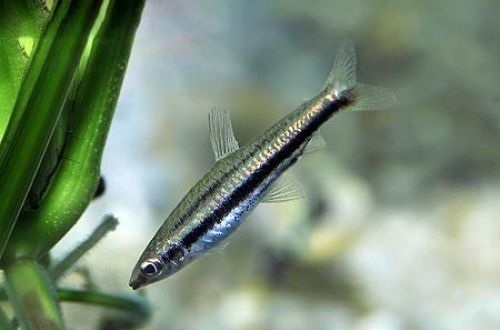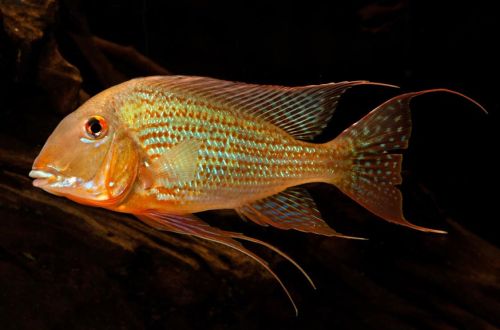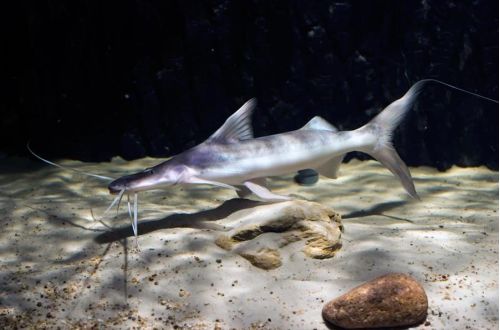
Nannostomus Marilyn
Nannostomus Marilyn, scientific name Nannostomus marilynae, belongs to the Lebiasinidae family. The fish is named after Marilyn Soner Weizmann, the wife of the biologist who first discovered and described this species of fish. They are relatively rare in amateur aquarists due to their unprepossessing coloration and certain difficulties with breeding.

Contents
Habitat
It comes from South America from the upper basin of the Rio Negro in the north of the Amazonas state in Brazil. Inhabits small tributaries, slow flowing streams, backwaters, swampy coastal areas. Prefers regions with dense aquatic vegetation and numerous submerged snags and tree roots.
Brief information:
- The volume of the aquarium – from 40 liters.
- Temperature – 21-28°C
- Value pH — 4.0–6.5
- Water hardness – soft (1-9 dGH)
- Substrate type – any dark
- Lighting – subdued
- Brackish water – no
- Water movement – little or no
- The size of the fish is about 3 cm.
- Meals – any
- Temperament – peaceful
- Keeping a flock of at least 10 individuals
Description
Adult individuals reach a length of 3 cm or more. Sexual dimorphism is weakly expressed, males and females have minor differences that are barely noticeable to the naked eye. The coloration is gray or silver, the body pattern consists of a thin dark strip stretching from head to tail. Fins and tail are translucent.
Maintenance and care, arrangement of the aquarium
Recommended aquarium sizes for a school of 10 fish start at 40–50 liters. In the design, it is necessary to provide for areas with dense aquatic vegetation, as well as a dark substrate. Plants floating on the surface are a useful addition, along with driftwood and bedding of dried leaves.
Leaves are not only an element of decor, but also allow you to give the water a chemical composition similar to that in which fish live in nature. A similar effect is achieved due to the release of tannins during decomposition.
The long-term success of keeping Marilyn Nannostomus depends on maintaining stable water conditions within an acceptable range of hydrochemical values and temperatures. To do this, in addition to installing the necessary equipment, it will be necessary to carry out regular maintenance of the aquarium: replacing part of the water with fresh water, timely removal of organic waste (food leftovers, excrement), etc.
Behavior and Compatibility
A peaceful calm fish, due to its size, is not able to compete with active large fish, so they should be avoided when kept together. Compatible with other species of comparable size that live in the water column or near the bottom. Parsing, small Tetras and the like will become excellent neighbors. It is advisable to purchase a flock of at least 10 individuals. With fewer numbers, nannostomuses can become overly shy.
Breeding / breeding
Breeding is quite possible in a home aquarium, but is associated with certain difficulties. The main problems are the predation of adult fish in relation to their own juveniles and the difficulty in feeding tiny fry.
The breeding season in the artificial environment is not pronounced. At the same time, some females will be ready to breed, while others will not, so in a large group of dozens of individuals, fry will appear quite often.
During spawning, females scatter eggs in thickets of plants, after which they leave them without showing parental care. On occasion, as noted above, the fish will eat the eggs and juveniles that have appeared. In order to preserve the brood, it or the unhatched eggs must be moved to a separate tank with identical water conditions. Fry should be fed with specialized powdered feed, suspensions, and, if possible, ciliates.
Fish diseases
Health problems arise only in case of injuries or when kept in unsuitable conditions, which depresses the immune system and, as a result, provokes the occurrence of any disease. In the event of the appearance of the first symptoms, first of all, it is necessary to check the water for the excess of certain indicators or the presence of dangerous concentrations of toxic substances (nitrites, nitrates, ammonium, etc.). If deviations are found, bring all values back to normal and only then proceed with treatment. Read more about symptoms and treatments in the Aquarium Fish Diseases section.





